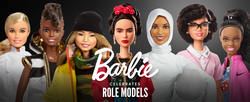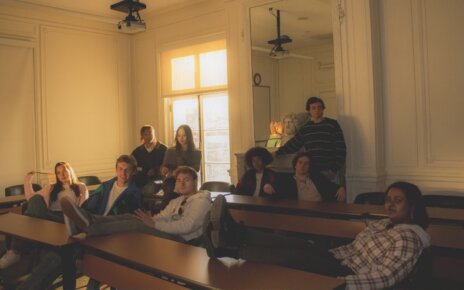Mattel’s Barbie dolls have been around since 1959, when Co-Founder, Ruth Handler designed the original Barbie figure and debuted her at the New York Toy Fair.
Since then, the dolls have transformed over the past 55 years; Barbie has become a nurse, teacher, astronaut, game developer, and most recently, a president. The newest addition to the collection of dolls is the design of the Inspiring Women series.
This series includes influential women figures throughout history portrayed as Barbie dolls such as Frida Kahlo, Amelia Earhart, Katherine Johnson, and soon to come Chloe Kim, Ibtihaj Muhammad, and many other women both past and present.
The idea of a ‘Shero’ or a female hero is not unheard of in today’s society.
Michael Chattalas, Ph.D., a specialist professor of marketing and international business said, “Society’s stereotype of a ‘hero’ is adjusting to changing gender roles. My own research on cultural stereotypes, suggests that an ideal ‘hero’ figure should exude both competence and warmth, which could be a perfect fit for Barbie’s Shero image.”
According to Mattel’s website, “86 percent of moms surveyed are worried about the kind of role models their daughters are exposed to [according to a 2018 online survey].”
“That’s why Barbie continues to showcase examples of inspirational women. From Sheroes to Inspiring Women, meet our latest Barbie role models–all extraordinary women we’ve honored with a doll in their likeness.”
While the implementation and introduction of women figures for girls to look up to is well and good, one of the biggest concerns with this new development is the accurate depiction of the Frida Kahlo doll. Kahlo’s great niece, Mara de Anda Romeo, believes that Mattel does not have the rights to utilize the image of Kahlo.
Julia Riordan-Goncalves Ph.D., Director of the Spanish and International Business Major and Spanish for Business Minor and an assistant professor of Spanish said, “I was a bit skeptical because I imagined a Frida Kahlo doll that would look like a traditional Barbie. It seemed to me that it might me a marketing stunt or a half-hearted way to recognize International Women’s Day. But, I’m glad to see that the project is well thought-out.”
According to The Guardian, critics have also said that the doll is not reflective of Kahlo’s distinct characteristics such as her heavy eyebrows and her ‘costume’ is not representative of the Tehuana-style dresses the artist normally wore
Mattel said in a statement that the doll, “Celebrates the ideological contributions of Frida Kahlo which have transcended the borders of art and which will influence new generations as a world icon through the Frida Kahlo Barbie, which conserves the essence of Barbie and the legacy of Frida Kahlo.”
Stephanie Vela, a senior social work and Spanish student said, “Frida Kahlo is an influential person and a name that will always be known, so I think the family has a right to defend her legacy. Barbie should be more understanding of the family’s input and do their best to make sure the doll accurately represents Frida Kahlo.”
“Growing up, I played with Barbie dolls a lot and remember always looking for ones that looked more like me. I think it’s great that Barbie wants to have a Hispanic female role model, but if they’re going to do that, they definitely have to try and do it right,” Vela continued.
Lisa Dinella, Ph.D., an associate professor of psychology said, “Mattel’s line of Shero dolls is intended to recognize the important contributions that women have made to our collective culture.”
“Scientific studies confirm the importance of children seeing themselves reflected in their toys and in media, and of having role models who inspire and encourage them. Concern has been raised in the past about Barbie’s promotion of idealized beauty standards and the toy line’s emphasis on the importance of girls’ physical appearance,” Dinella added
“I think that including women like Frida Kahlo in a line of dolls honoring women who have not been included in toy lines such as this is a wonderful idea. The doll will come with educational material that children can read to find out more about Frida and her contributions to art and Hispanic culture.”
Inclusion of Hispanic historical figures has been sparse in the past, Riordan commented, “[The inclusion of these Barbies is] quite timely as we see an increasing awareness surrounding issues women’s rights and gender equality throughout the world. Introducing Frida Kahlo in this way to younger children makes it a normal, everyday occurrence that lessens the perception of women like her as different or of lesser importance. I hope that the production of this line of dolls continues for many years so that Frida and the other incredible women highlighted in the doll series come to be very well-known and highly recognizable for their accomplishments,” Riordan said.
Chattalas commented, “This is yet another effort by Barbie to mirror and celebrate America’s cultural, racial, and ethnic diversity. Given their choice of artist role-models (like Frida), I suspect the new dolls may actually be targeting parents and collectors as well as children.”
“I am happy to see Mattel address these concerns via their Fashionista line, which includes dolls with diverse body shapes, skin tones, and hair types. Although this line of Shero dolls does not remedy all of the concerns about Barbie, it is definitely a step in the right direction” Dinella said.
IMAGE TAKEN from barbie.mattel.com




